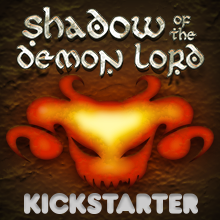KICKSTARTER: Choose your Path!
One of the most exciting things about Shadow of the Demon Lord is how characters evolve. The path system lets you develop your character in response to what happens in the story. With no requirements to meet and no restrictions on what paths you can choose, the game system liberates you to play whatever the heck you want to play.
Starting Characters
Creating a starting character involves making one really big choice: Ancestry. Your ancestry describes the people from which you character comes. Will you be a human or a dwarf, a devil-spawned cambion, or a person made from clockwork? Once you make this choice, you record the mechanics from the ancestry: starting attributes, characteristics, as well as any talents you might have.
After you make your decision, you can flesh out details about your character. Details include your professions (tracker, burglar, soldier), background events, personality details, religious beliefs, physical appearance, and so on. All these things can be determined randomly, chosen, or invented. They don’t have any mechanical weight and are there to help you visualize how the person you play fits into the world.
The last step is to record your starting equipment. Everyone starts with the same things, a basic weapon, a miscellaneous item, and a random interesting thing—a reputation for being a bad ass, a tiny metal ball that floats a few inches above any surface where it is placed, or a tiny mechanical owl.
With your character created, you’re ready to play your first adventure. This story typically focuses on how your group comes together and lays the groundwork for how your character will develop. While playing, you should think about the actions your character takes, the choices you make, and how you contributed to the story’s outcome.
Group and Level
The first adventure behind you, your character should belong to a group of characters. Your group has a level that starts at one and increases by one each time you complete another adventure. At key levels, you and the other members of the group choose paths. Your path choice tells you the things your character knows how to do and delivers talents, magic, and other benefits for each level of your group.
Level What happens
1 Choose a novice path and gain the level 1 benefits.
2 Gain the level 2 benefits from your novice path.
3 Choose an expert path and gain the level 3 benefits from that path.
4 Gain the level 4 benefits from your ancestry.
5 Gain the level 5 benefits from your novice path.
6 Gain the level 6 benefits from your expert path.
7 Choose a master path and gain the level 7 benefits from that path.
8 Gain the level 8 benefits from your novice path.
9 Gain the level 9 benefits from your expert path.
10 Gain the level 10 benefits from your master path.
Novice Paths
The game includes four novice paths: magician, priest, rogue, and warrior. You can choose any path you want, usually in response to what happened during your first adventure. If you fought a lot, you might become a warrior. If you used trickery or spent much of your time sneaking around, you might choose rogue. Finding an incantation and casting it could lead you to become a magician or priest.
Of all the path choices, your novice path gives you the most benefits. The higher number of benefits protects you from making suboptimal choices later on, thus freeing you to choose the paths that fit your character’s story. As a warrior, you will always be great at fighting, even if you choose other paths that have nothing to do with fighting. Similarly, as a priest, you will always be good at helping others, lending support through the prayers you whisper.
Adventures for novice characters tend to be reactive. Something happens to you group and you must find ways to deal with the problem the event causes. Psychotic bandits could be butchering families on the fringes of the town, a bloody bone released from an ancient elfin vault steals a farmer’s hogs for their hides, or a group of misguided followers of the Horned God kidnap a friend of the group and make ready to sacrifice that friend to a twisted black tree in the center of the woods are all good examples of the kinds of things novice characters might do.
Expert Paths
At level 3, everyone in the group chooses an expert path. Your choice indicates the area in which your character pursues expertise. Do you want to be an assassin, wizard, shaman, berserker, or a thief? The choice may complement your novice path choice, developing your existing capabilities or take your character in an entirely new direction. Since your novice path acts as your foundation, taking something different does not hamper your capabilities and may open up interesting avenues for you to explore in future adventures.
As with your choice of novice path, your expert path tends to reflect what has happened in the story so far. If you began as a warrior, let’s say, and you stole a tome filled with Forbidden spells and you even go so far to cast spells from that tome, you might choose wizard for your expert path to show how those experience altered your journey. Similarly, a rogue who spends much of her time skulking in the shadows and taking out enemies from hidden positions would likely choose assassin.
Expert adventures take characters into deadlier environments. Characters might explore the countless doorways of a weird tower that appears in the Blasted Heath when the moon is full, venture into the Desolation, battling through hordes of zombies, to reach one of the fabled black pyramids that stab up from the swirling sands. Expert characters offer players more options, greater power, and increased durability to help them withstand the trials they must endure.
Master Paths
When the group reaches level 7, everyone can either choose a master path or a second expert path. Master paths zoom in one thing your character does very well, while a second expert path diversifies your capabilities. Examples of master paths include death dealer, dreadnaught, executioner, conqueror, curse-speaker, pyromancer, and more.
Again, you can choose any path you want, which frees you evolve your character based on the story. A warrior who became a wizard could choose to become an inquisitor after having a brush with dark magic, or become a mage knight, weaving magic with fighting ability. The thief who became an assassin could become a shadowbinder and supplement the assassination techniques with magic or become a gunslinger and become a badass with ballistic weapons.
Master path adventures are the most challenge and take characters into terrifying places. The group might descend into the depths of Hell to recover a powerful relic or rescue a damned soul, or they may confront a powerful demon that wears a mortal disguise and hastens the end of all things at the Fortress of Oblivion.
Above 10?
The plan has always been to include material for groups that reach level 10 and would continue playing. Stay tuned for more details about how this will work.
Final Thoughts
In the game, Conan the Barbarian would have started as a warrior, become a thief, and finally a conqueror. The system for character improvement lets you play whatever you want to play and let the story shape your character into a unique and interesting individual.
Since the game packages almost all character benefits inside paths, it’s easy to build a character to join a group at any level. Just choose your paths and note the benefits you gain from them for the level.
Finally, you can create new paths or exclude other ones without wrecking the game. If you don’t want clockwork people, don’t have them. No gods? No problem. Rip out the priest and associated paths and you’re good to go. The game plays just fine without them.

